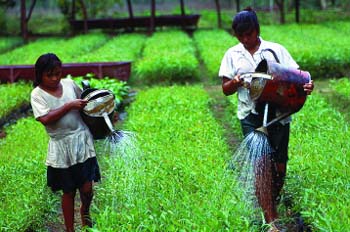
|
OBJECTIVES |
Explain how to integrate the gender perspective in human resources management and in the design of Terms of References (TORs) for emergency operations.
|
KEY CONCEPTS |
Human resources management, Key Informants and facilitators, Qualifications, Relief Operations, Situation and needs assessment, Targeting procedures, Terms of Reference.
Lessons learned from emergency response reveal that programme interventions and life saving strategies are made more efficient and timely when there is a real understanding of men’s and women’s different needs, interests, vulnerabilities, capacities and coping strategies.
Human resources should be considered important assets in rehabilitation and recovery planning and operations. Their planning and management concern emergency operators at all levels as well as other stakeholders and beneficiaries.
Local and international capacity building for gender mainstreaming is essential in the delivery of any emergency operation, particularly towards achieving sustainable interventions. In this regard, a set of actions may be required to strengthen the capability of participants and other stakeholders involved in project implementation processes.
Emergency operators should be qualified and subsequently held accountable for the degree of gender-sensitivity conducted in their operations. Consequently, there is a need to explicitily address gender equity in the design of Terms of Reference and Sectoral socio-economic and gender analysis should be incorporated.
To initiate the participatory targeting process in the field, key informants should be identified during the situation and needs assessment phase of the emergency.
Appropriate gender representation is fundamental when identifying key informants. It is important to ensure that women are equally represented among key informants, and to consider that gender structures are both in transition and inherited from pre-disaster patterns. Women often play an important role as bearers of the knowledge of community structures. Highly qualified women informants, with knowledge of the differentiated socio-economic organisation and trend dynamics, should be identified.
Key informants of the impact assessment phase often become the key facilitators during the operation phase. They should be locally identified and selected, taking into account their current capacity to reach and assist the vulnerable population.
The needs identified should be met by the basic inputs of a relief programme proposed to the donor community. The areas of intervention and the most affected people should be identified (disaggregated by sex).
Sex-disaggregated background information should be gathered from different existing sources and databases at country and field levels. The information collected from the country’s institutional sources and the databases of aid agencies should be reviewed in terms of socio-economic and gender analysis. For complex emergencies, the information should be analysed with Key Informants in the new context, considering the changing trends in the existing structures.
This information represents a reference for emergency operators to identify and assess the diversified impacts on men and women, to be ascertained with participatory tools, at general and local context. The immediate relief needs of the most vulnerable affected by a disaster, analyzed by sex, should be assessed with a participatory process in order to restore their minimum food security and acceptable livelihood status.
Project documents should cover the needs identified for the intervention and background information on the area context. They should include a justification, rationale, description of the operation (location and number of male and female beneficiaries) and implementation strategy modalities (including distribution modes), technical specifications for the relief packages, and cost estimates of the operation.
The in-depth process of area and beneficiary segregation and selection is performed at the inception of the relief operations, based on the results of the impact assessment phase. This requires the building of an additional information system to identify individual beneficiaries, with the maximum participation of all stakeholders.
For the implementation, national NGOs with a ‘commitment to women’ mandate and women’s associations at the operational level should preferably be selected as partners for targeting female-headed households. The final estimation of target beneficiary numbers and their location will be based on vulnerability mapping and agreed with the implementing operators and partners.
In order to follow a gender perspective in administrative screening, proper agreements with aid administrators should be reached, based on the reliability and validity of the results of a vulnerability mapping exercise carried out during needs assessment.
A matrix combining all the collected information (including recommended relief packages) should be built. This should define the quantity of goods and services to be provided to the target group, in order to achieve the desired impact of the project activities. The result of this process will be used for the preparation of allocation and distribution plans. Appropriate screening tools for administrative, community or self-targeting mechanisms should be selected to ensure that only those who meet the targeting criteria actually receive the benefits.
In the case of a community targeting procedure, a gender perspective in aid distribution will depend on the community’s level of organization, which should be thoroughly evaluated prior to choosing this option.
A self-targeting approach implies choosing an aid package that only the target population wants (including a cost that only the target beneficiary is willing to pay). When targeting female-headed households the results of the livelihood and farming systems analysis should be taken into account to understand the effectiveness and applicability of such a procedure. The prevailing workload of women and existing relations with their actual nourishment and health status should be considered.
The extent to which interventions actually cover all those experiencing acute and exceptional food insecurity should be judged. The timing and duration of sustained forms of reconstruction, rehabilitation and recovery should also be evaluated. Actual beneficiary numbers should be monitored and compared with provisional figures established at project inception.
|
|
|
|
|